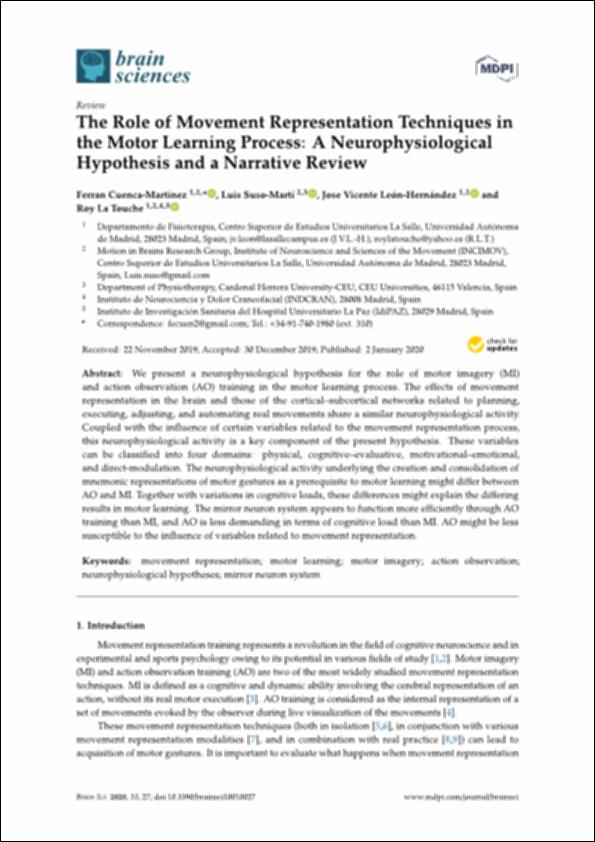Please use this identifier to cite or link to this item:
http://hdl.handle.net/10637/12866The role of movement representation techniques in the motor learning process : a neurophysiological hypothesis and a narrative review
| Title: | The role of movement representation techniques in the motor learning process : a neurophysiological hypothesis and a narrative review |
| Authors : | Cuenca Martínez, Ferran Suso Martí, Luis León Hernández, José Vicente La Touche Arbizu, Roy |
| Keywords: | Movimiento - Fisiología.; Movement, Physiology of.; Neurofisiología.; Neurons.; Movimiento - Aprendizaje.; Motion - Knowledge and learning.; Neuronas.; Neurophysiology. |
| Publisher: | MDPI |
| Citation: | Cuenca-Martínez, F., Suso-Martí, L., León-Hernández, J.V. & La Touche, R. (2020). The role of movement representation techniques in the motor learning process: a neurophysiological hypothesis and a narrative review. Brain Sciences, vol. 10, i. 1 (02 jan.), art. 27. DOI: https://doi.org/10.3390/brainsci10010027 |
| Abstract: | We present a neurophysiological hypothesis for the role of motor imagery (MI) and action observation (AO) training in the motor learning process. The e ects of movement representation in the brain and those of the cortical–subcortical networks related to planning, executing, adjusting, and automating real movements share a similar neurophysiological activity. Coupled with the influence of certain variables related to the movement representation process, this neurophysiological activity is a key component of the present hypothesis. These variables can be classified into four domains: physical, cognitive–evaluative, motivational–emotional, and direct-modulation. The neurophysiological activity underlying the creation and consolidation of mnemonic representations of motor gestures as a prerequisite to motor learning might di er between AO and MI. Together with variations in cognitive loads, these di erences might explain the di ering results in motor learning. The mirror neuron system appears to function more e ciently through AO training than MI, and AO is less demanding in terms of cognitive load than MI. AO might be less susceptible to the influence of variables related to movement representation. |
| Description: | Este artículo se encuentra disponible en la siguiente URL: https://www.mdpi.com/2076-3425/10/1/27 |
| URI: | http://hdl.handle.net/10637/12866 |
| Rights : | http://creativecommons.org/licenses/by/4.0/deed.es |
| ISSN: | 2076-3425 (Electrónico). |
| Issue Date: | 2-Jan-2020 |
| Center : | Universidad Cardenal Herrera-CEU |
| Appears in Collections: | Dpto. Enfermería y Fisioterapia |
Items in DSpace are protected by copyright, with all rights reserved, unless otherwise indicated.


